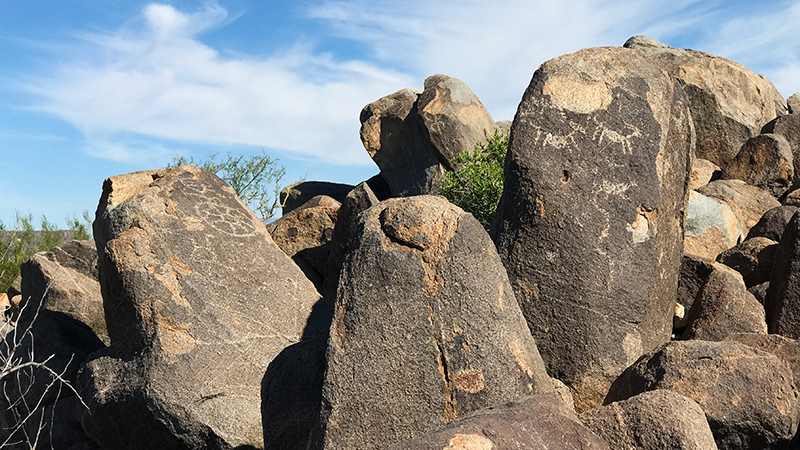
While the giant Saguaro Cacti are pretty amazing to see — and we saw thousands of them while walking the Desert Discovery Trail and the Valley View Overlook Trail — when we found out there are also ancient petroglyphs at Saguaro National Park, we made sure not to miss that trail!
The Signal Hill Petroglyph Site, immediately north of the Signal Hill Picnic Area, is the largest petroglyph site in the Tucson Mountain District of Saguaro National Park. It boasts more than 200 prehistoric Native American petroglyphs and many can be seen right from the trail.
Signal Hill Petroglyph Trail is an easy out and back walk to the top of Signal Hill that totals about 0.25 mile. It begins at the Signal Hill Picnic area, which was built by the Civilian Conservation Corps in the 1930s. Near a covered picnic spot, the trail quickly drops down into a wash before climbing 40 feet to the top of Signal Hill with just a few stairs along the dirt trail.
When leaving the wash, look up to the rocks atop the hill as you walk and you’ll see ancient etched petroglyphs adorning the rocks.
At the top of Signal Hill is a petroglyph viewing area that looks out over a rocky outcropping dotted with clear, easily visible petroglyphs.
Created approximately 550 to 1550 years ago, most of the rock art found in Saguaro National Park is from the prehistoric Hohokam. The Hohokam were farmers, gatherers and hunters who lived in the river valleys and deserts of southern Arizona from about 450 to 1450 AD. Their representational and abstract designs include animals, humans, and astrological objects, as well as circles, spirals, dots, and wavy lines.
This short detour off the scenic Bajada Loop Drive is well worth the stop and provides a unique look into the area’s past.
Know Before You Go
About The Signal Hill Petroglyphs and Picnic Area:
- The Signal Hill Petroglyph Site consists of more than 200 prehistoric Native American petroglyphs, several of which are easily seen from the trail.
- The Signal Hill Picnic Area is one of four picnic areas in the Tucson Mountain District at Saguaro West. The others are Sus, Cam-boh, and Ez-kim-in-zin. Each picnic area has at least one picnic table with an overhanging end for wheelchairs and an accessible vault toilet. Some spaces have charcoal grills nearby.
- The picnic area and Hohokam petroglyphs are located off the scenic 6.0 mile Bajada Loop Drive on Signal Hill Road in Tucson, Arizona 85743.
- Oils from your hands can damage the petroglyphs. Look and take photos but do not touch the petroglyphs or take rubbings.
About Saguaro National Park:
- Saguaro National Park is open 365 days per year. You can walk or bike into the park 24 hours a day. Vehicle access is from sunrise to sunset daily.
- Admission to the park is $15.00/vehicle, $10.00/motorcycle, or $5.00/person and $5.00/bicycle. Free admissions days are offered on Martin Luther King, Jr. Day, the first day of National Park Week, National Public Lands Day, and Veterans Day.
- The national park is split into two separate sections, one on each side of the city of Tucson, Arizona in Pima County: the Rincon Mountain District to the east and the Tucson Mountain District to the west.
- Red Hills Visitor Center in the Tucson Mountain District of Saguaro National Park is located at 2700 North Kinney Road, Tucson, Arizona 85743. It is open daily from 9:00 am to 5:00 pm and closed on Christmas Day.
- View maps of Saguaro National Park’s two scenic loop drives and numerous hiking trails and download the park newspaper.
- There are no concession stands, snack/soda machines or restaurants in either section park. Water fountains are found at both visitor centers and only there.
- There is little to no cell reception of service through the entire national park.
- Pets are allowed only on roadways, picnic areas, and the two paved trails — the Desert Ecology Trail and the Desert Discovery Trail. Pets must be on a leash of no more than six feet at all times.
- All resources (living and non-living) are protected in the National Park. Picking/taking of any resource is prohibited.











